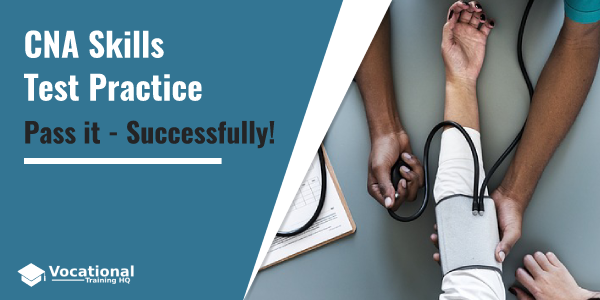After completing the required CNA training, you need to sit for the exam in order to get your license.
To be able to pass this test, you need to have excellent knowledge that can be obtained during your training.
The Certified Nursing Assistant exam consists of two parts.
The first one is a written test while the next one is clinical skills verification.
To pass the exam, you need to pass both sections successfully with at least a 70% success rate.
When it comes to the written part, it contains multiple-choice questions and is taken on a computer.
Speaking of the second part, you need to complete several practical tasks performing them before an evaluator.
Just make sure that skills related to some critical CNA duties and performed during the test are shown properly.
Usually, this section may include tasks that cover from three to six skills.
Despite the fact that you need to show proficiency only in some skills, don’t forget that it is designators who choose those skills using the list of about 30 different options.
Also, you need to know that the second section of the exam is held in a clinical setting and replicate CNAs real working environment.
It means that you need to have well-developed skills and show your competency properly.
Article Table of Contents
CNA Skills
During the CNA’s skills test you need to show your proficiency in some skills from this list:
- Applying knee-high elastic stockings;
- Ambulation using a transfer belt;
- Assisting with bed baths;
- Bedpan assistance;
- Counting and recording respirations;
- Denture cleaning;
- Dressing clients with weak or injured arms;
- Feeding patients;
- Foot care;
- Hand Hygiene;
- Moving the patient from a wheelchair to a bed using a transfer belt;
- Perineal care;
- Patient side positioning;
- Providing mouth care;
- Recording a radial pulse;
- Recording and measurement of a patient or client’s blood pressure, weight, and urinary output.
In some states, during this test, applicants may be obliged to record a measurement.
It may include such aspects as:
- Blood Pressure;
- Radial pulse;
- Respirations;
- Urinary output;
- Weight.
During this part of the exam, you need to perform tasks with the help of actual “patients” or “clients”.
It means that you need not only to perform some duties but to communicate with a subject as well.
As a future CNA, you need also show that you know how to perform proper sanitary practices such as washing hands and disposing of waste.
Also, you need to show your positive attitude and demeanor in order to prove that you can take care of your patients and their needs.
It means that you need to practice not only your professional skills as well as your communication skills.
As a CNA, you need to understand that it is not only direct skills such as placing a patient in a proper position but also kindness and care can help your patients feel better.
Also, you can get some extra points during your exam if you have a great understanding of what you need to perform various duties.
It is important to understand that the practical test aims to prove that you aren’t only proficient but also know how to keep your clients safe.
Different test providers check different skills and it is a state that decides on a test provider.
There are test providers listed state by state:
- American Red Cross, approved university, or private entities: IL, IN, KY, MA, ME, UT, WV;
- Headmaster: AZ, MT, ND, NH, NJ, NV, OH, OR, SD, TN, VT;
- Pearson VUE: AL, AK, CA, CO, DC, GA, LA, MD, MN, MS, NH, NC, ND, PA, RI, SC, TX, VA, VT, WA, WI, WY;
- Prometric: AL, AR, CT, DE, FL, HI, ID, LA, MI, NM, NY, OK, WY;
Below, you can find info about the list of skills tested by each provider.
| Skill | Pearson Vue | Prometric | Headmaster |
|---|---|---|---|
| Hand Hygiene (Hand Washing) | x* | x* | x |
| Applies one knee-high elastic stocking | x | x | |
| Assists to ambulate using transfer belt | x | x* | x |
| Assists with use of bedpan | x | x | x |
| Cleans upper or lower denture | x | x | x |
| Counts and records radial pulse | x | x | x |
| Counts and records respirations | x | x | x |
| Donning and removing PPE (gown and gloves) | x | ||
| Dresses client with affected arm | x | x | |
| Feeds client who cannot feed self | x | x | x |
| Gives modified bed bath (face and one arm, hand and underarm) | x | x | |
| Measures and records blood pressure | x | x | |
| Empty, measure and record urinary output | x | x | |
| Measures and records weight of ambulatory client | x | x | |
| Performs modified passive range of motion (PROM) for one knee and one ankle | x | x | |
| Performs modified passive range of motion (PROM) for one shoulder | x | x | |
| Positions client on side | x | x | x |
| Provides catheter care for female | x | x | |
| Provides foot care on one foot | x | x | |
| Provides mouth care | x | x | x |
| Provides perineal care (PERI-CARE) for female | x | x | |
| Transfers from bed to wheelchair using transfer belt | x | x | x |
| Indirect Care | x* | ||
| Change bed linen while the resident remains in bed (not tested in Wyoming) | x | x | |
| Provide hand and nail care | x | x | |
| Gives partial bed bath and back rub | x | ||
| Provide resident with passive range of motion (ROM) exercises to one elbow and wrist | x | ||
| Abdominal Thrust | x | ||
| Ambulation with cane or walker | x | ||
| Back rub | x | ||
| Dressing client | x | ||
| Fluid intake | x | ||
| Hair care | x | ||
| Mouthcare of a comatose client | x | ||
| Passing fresh water | x | ||
| Range of motion exercise | x | ||
| Transfer from wheelchair to bed using a gait belt | x |
A required skill is indicated with * in the table.
How To Prepare and Practice For Skills Test
The job training is the best way to get ready for the skills test so you can get your certification.
It is not enough to know the test requirements to pass it, you actually need to have some practice outside the healthcare facility.
The test aims not only to ensure your proficiency in those skills but also to the fact that you can take proper care of patients.
To brush up your skills before the test, you can watch some educational videos that contain instructions on various tasks.
Also, make sure to spend some time practicing at least some of the critical CNA skills.
You can always ask your family and friends to help you with your practice.
Before starting your practice, make a checklist and give it to your family member or friend so they can check whether you follow all the steps.
You need to practice as much as you can to make these skills become your second nature.
Also, you need to keep in mind that your patient’s safety, rights, and needs are your main priority.
During the exam, the evaluators pay much attention to the way you treat your patient.
Considering the fact you need lots of practice, it is a good idea to look for a place you can volunteer at.
Also, you can get in touch with training instructors and ask them if they can allow you practicing.
One other great option is some Red Cross locations that provide a variety of practice testing materials.
Just keep in mind that lots of practice are your key to success.
State-Specific Requirements
Before applying for the certification exam, you need to complete an approved CNA training program that is approved by your state.
Just make sure to check the requirements for the test in your state as they may differ from one state to another.
Also, each state has a list of approved training programs so make sure to check it before choosing the program.
Each state establishes its own number of questions and time limitations for the test.
Moreover, some states use the term “Nursing Aid” instead of “Certified Nursing Assistant” that may lead to some confusion.
So don’t panic if you cannot find a CNA abbreviation in your state and try to look for Nursing Aid options.
After completing the CNA exam, you’ll be able to obtain your license.
You need to remember that your license should be renewed every two years and each state determines whether some extra training is required for its renovation.
One other point is that this training will cost you money but most employers reimburse their CNA.
Additional Resources
- How to Get Ready for Your CNA Test?
- CNA Training Online: Get Your Certificate Now!
- How to Become a CNA: The Definitive Guide
- Free CNA Training in Nursing Homes and Hospitals
- CNA Classes: Red Cross, Free & Paid Training
Good luck!
Read the full guide: How to Become a CNA

